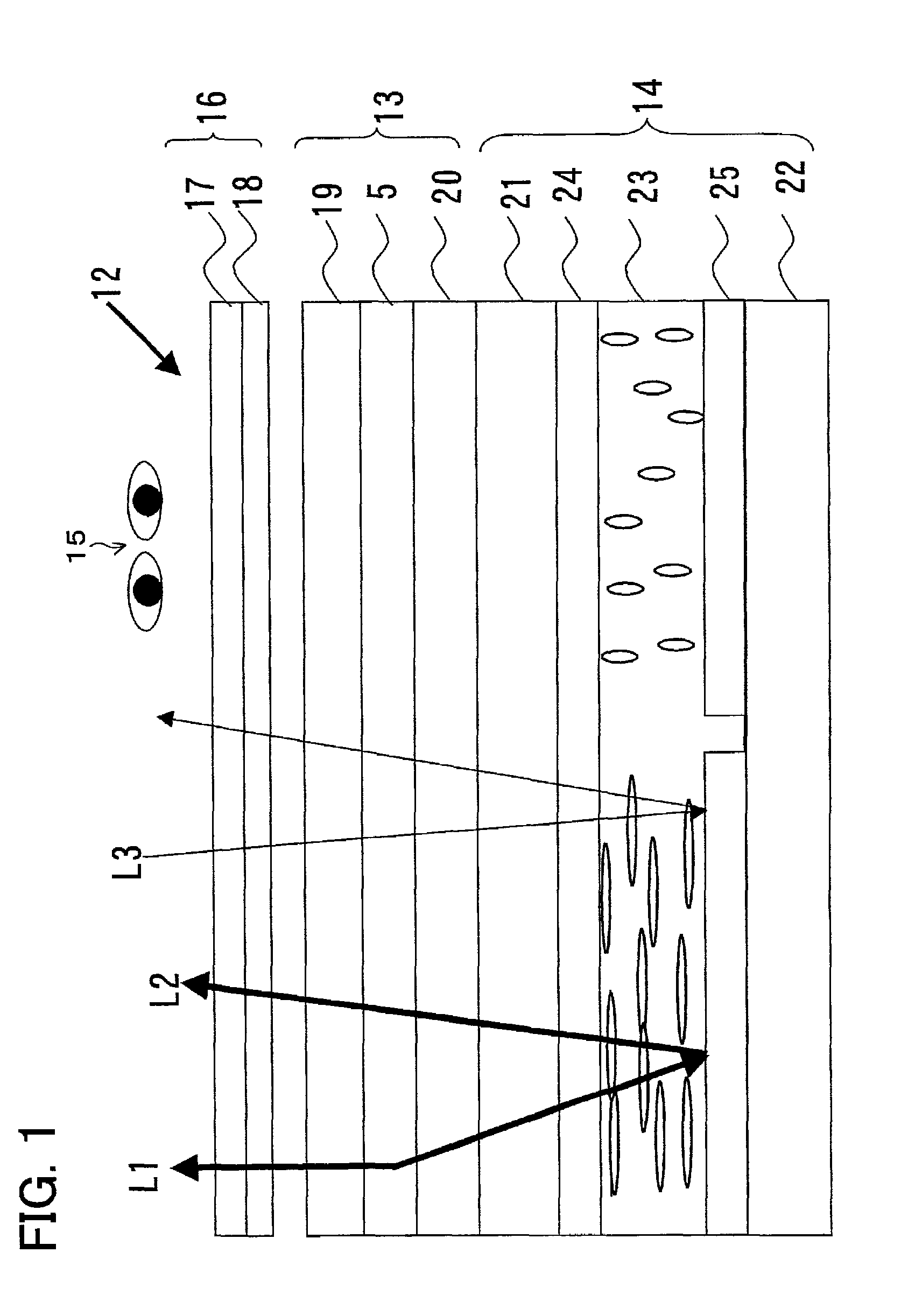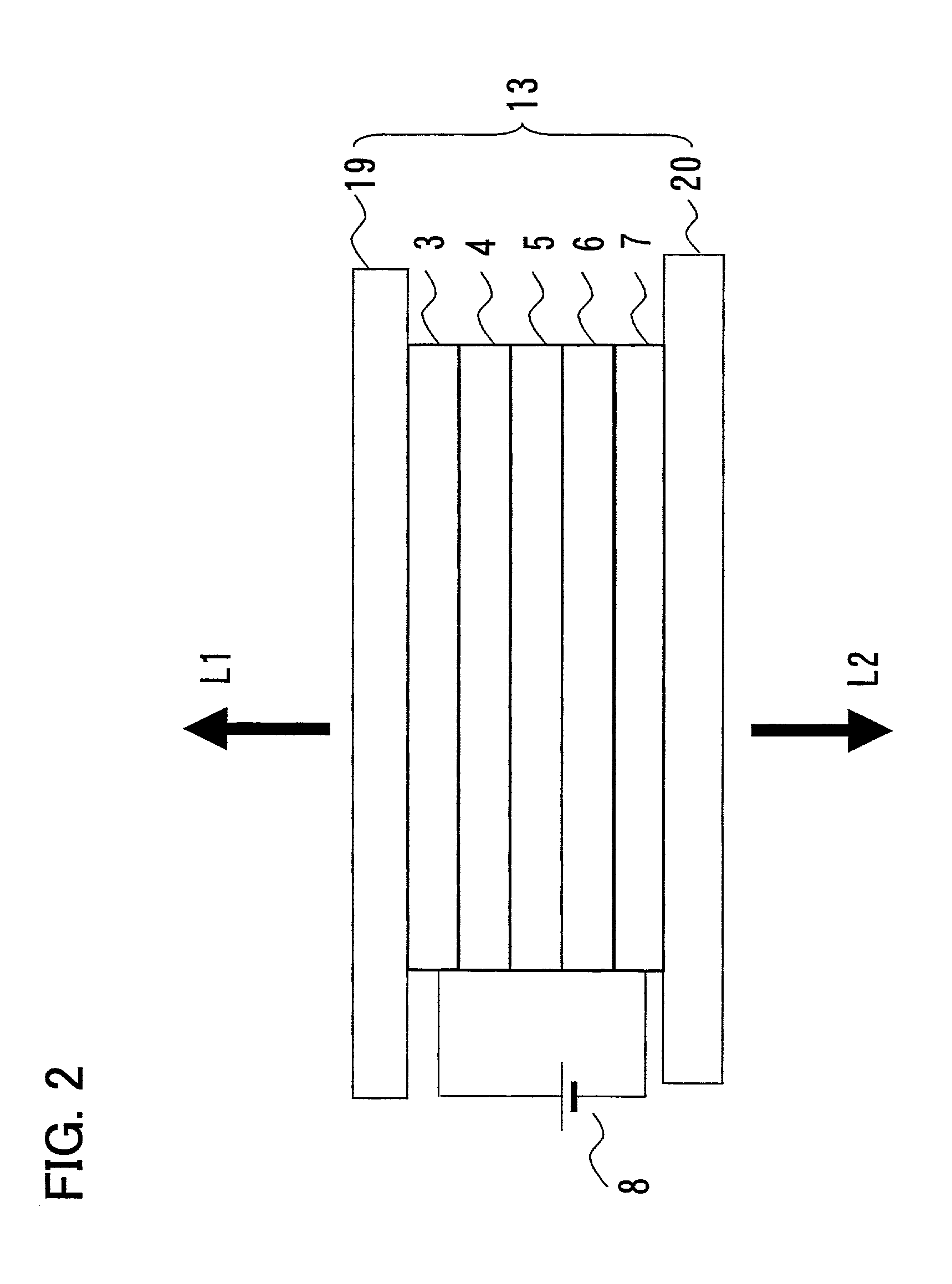Display
a thin, lightweight technology, applied in the field of thin, lightweight displays, can solve the problems of reducing contrast, over-high luminance of non-emitting states, unrecognizable screens, etc., and achieve the effect of small thickness and light weigh
- Summary
- Abstract
- Description
- Claims
- Application Information
AI Technical Summary
Benefits of technology
Problems solved by technology
Method used
Image
Examples
embodiment 1
[0059]FIG. 1 is a schematic cross-sectional view of the structure of a display 12, a first embodiment in accordance with the present invention. There is provided a reflective display element 14 integrally on the back of a transmissive EL element 13 and a circularly polarizing means 16 on the side thereof facing an observer 15. These two elements and the observer are located opposite to one another.
[0060]It is presumed here that the elements 13, 14 are driven by simple matrix addressing scheme; they may be however driven by active matrix addressing scheme. The EL element is an organic type, the reflective display element is a reflective type containing liquid crystal, and the circularly polarizing means has a layered structure including a polarizing plate 17 and a quarter-wave plate 18; however these are mere examples and by no means intended to restrict the scope of the invention.
[0061]The EL element 13 has a light-emitting layer 5 formed on a transparent substrate 19 and is covered...
embodiment 2
[0083]FIG. 9 shows another display in accordance with the present invention having a structure which is capable of displaying full colors when the EL element 32 is powered on, owing to the formation of RGB light emission patterns in the light-emitting layer 31 in the EL element 32. There is no change in the rest of the basic structure from embodiment 1.
[0084]The light-emitting layer 31 is formed, as an example, as follows: fabricate a body composed of a red-light-emitting organic layer and an electrode stacked thereon by vacuum vapor deposition. Move the mask parallel and stack a green-light-emitting organic layer on the electrode by vacuum vapor deposition. Finally, move the mask further parallel and stack a blue light-emitting organic layer on the electrode.
[0085]A concrete example is now given of the formation method of the light-emitting layer 31. The organic layer providing green light emission is formed by vapor-depositing, as a hole transfer layer, N,N -diphenyl-N,N′-bis(3-me...
embodiment 3
[0089]FIG. 10 shows another display in accordance with the present invention having a structure, enabling full color displays in either of the aforementioned display schemes, in which RGB light-emitting patterns are formed in the light-emitting layer 31 in the EL element 32 and a color filter layer 35 is formed on the transparent substrate 21 in the reflective display element 34. There is no change in the rest of the basic structure from embodiment 2.
[0090]In the figure, the display 33 has an almost identical structure to that of the display 30 of embodiment 2, but is characterized by the formation on the glass substrate 21 of a color filter layer 35 of a colorant dispersion scheme which is transparent to red, green, and blue light. The color filter layer 35 includes red, green, and blue-colored filters, arranged in stripes, which correspond to individual pixels in a single picture element. On the top of the color filter layer35 is there provided a flattening film 36 and a transpare...
PUM
| Property | Measurement | Unit |
|---|---|---|
| transmittance | aaaaa | aaaaa |
| thickness | aaaaa | aaaaa |
| transmittance | aaaaa | aaaaa |
Abstract
Description
Claims
Application Information
 Login to View More
Login to View More - R&D
- Intellectual Property
- Life Sciences
- Materials
- Tech Scout
- Unparalleled Data Quality
- Higher Quality Content
- 60% Fewer Hallucinations
Browse by: Latest US Patents, China's latest patents, Technical Efficacy Thesaurus, Application Domain, Technology Topic, Popular Technical Reports.
© 2025 PatSnap. All rights reserved.Legal|Privacy policy|Modern Slavery Act Transparency Statement|Sitemap|About US| Contact US: help@patsnap.com



